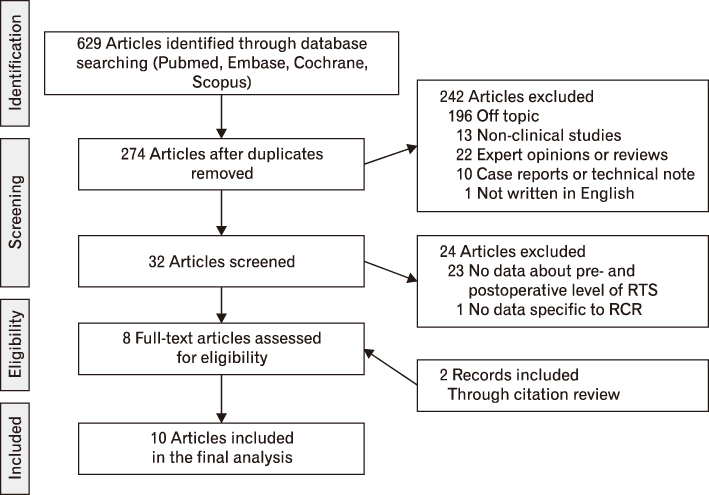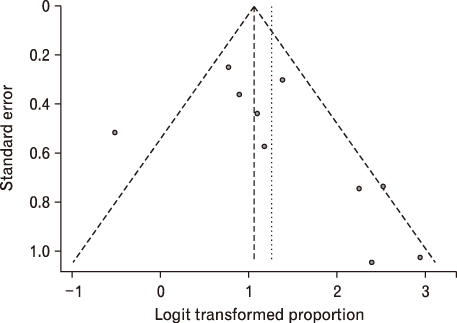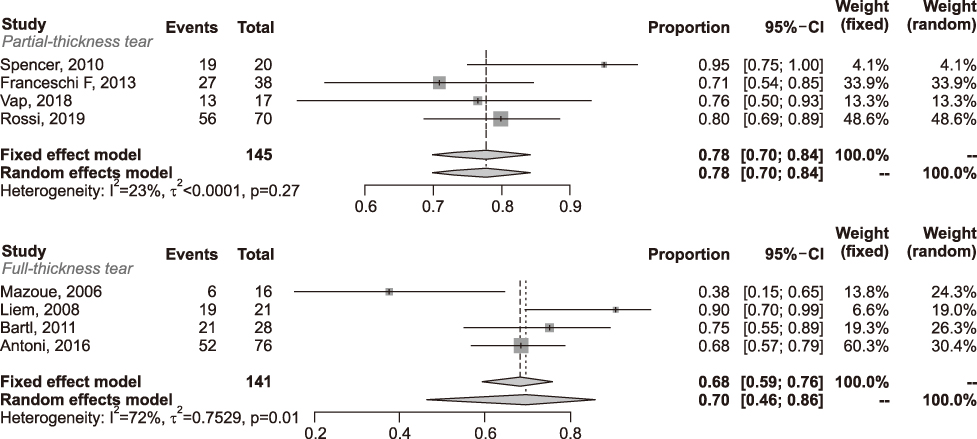Korean J Sports Med.
2019 Dec;37(4):121-129. 10.5763/kjsm.2019.37.4.121.
Return to Sports Following Rotator Cuff Repair: A Systematic Review and Meta-Analysis
- Affiliations
-
- 1Department of Orthopedic Surgery, Keimyung University School of Medicine, Daegu, Korea. oscho5362@dsmc.or.kr
- KMID: 2466800
- DOI: http://doi.org/10.5763/kjsm.2019.37.4.121
Abstract
- PURPOSE
Given the increasing common use of rotator cuff repair (RCR), return to sport (RTS) remains an important challenge and measure of success for athletes undergoing RCR. To determine the rate of return to the same level of sports after repair of rotator cuff tears.
METHODS
The PRISMA (Preferred Reporting Items for Systematic Reviews and Meta-Analyses) guidelines were followed to perform this systematic review and meta-analysis of the results in the literature. The electronic databases of PubMed, Embase, Cochrane Library, and Scopus were used for the literature search. Study quality was evaluated according to the MINORS (Methodological Index for Nonrandomized Studies) checklist. Studies evaluating the rate of return to the same level of sports after repair of partial- or full-thickness rotator cuff tears were included.
RESULTS
Ten studies were reviewed, including 357 patients who were treated with RCR and who had a mean follow-up of 48.1 months (range, 16-74 months). The overall rate of RTS was 88.6%. Among them, 77.9% (95% confidence interval [CI], 67.1%-86.0%) of patients were able to return to the same level of sports according to the meta-analysis. Subgroup meta-analysis revealed that partial-thickness rotator cuff tear was 77.9% (95% CI, 70.0%-84.1%), and full-thickness was 69.6% (95% CI, 46.3%-85.9%), but there was no statistical significance (p>0.05).
CONCLUSION
Most patients (88.6%) were able to return to sports after RCR and 78% of patients return to sports at the same level of play as before their injury.
MeSH Terms
Figure
Reference
-
1. Kaplan LD, Flanigan DC, Norwig J, Jost P, Bradley J. Prevalence and variance of shoulder injuries in elite collegiate football players. Am J Sports Med. 2005; 33:1142–1146.2. Economopoulos KJ, Brockmeier SF. Rotator cuff tears in overhead athletes. Clin Sports Med. 2012; 31:675–692.3. Plate JF, Haubruck P, Walters J, et al. Rotator cuff injuries in professional and recreational athletes. J Surg Orthop Adv. 2013; 22:134–142.4. Hart D, Funk L. Serious shoulder injuries in professional soccer: return to participation after surgery. Knee Surg Sports Traumatol Arthrosc. 2015; 23:2123–2129.5. Reuter S, Imhoff AB, Martetschlager F. Impact of rotator cuff surgery on postoperative sporting activity. J Sports Med Phys Fitness. 2018; 58:480–488.6. Spencer EE Jr. Partial-thickness articular surface rotator cuff tears: an all-inside repair technique. Clin Orthop Relat Res. 2010; 468:1514–1520.7. Dines JS, Jones K, Maher P, Altchek D. Arthroscopic management of full-thickness rotator cuff tears in major league baseball pitchers: the lateralized footprint repair technique. Am J Orthop (Belle Mead NJ). 2016; 45:128–133.8. Liu JN, Garcia GH, Gowd AK, et al. Treatment of partial thickness rotator cuff tears in overhead athletes. Curr Rev Musculoskelet Med. 2018; 11:55–62.9. Moher D, Liberati A, Tetzlaff J, Altman DG. PRISMA Group. Preferred reporting items for systematic reviews and meta-analyses: the PRISMA statement. PLoS Med. 2009; 6:e1000097.10. Slim K, Nini E, Forestier D, Kwiatkowski F, Panis Y, Chipponi J. Methodological index for non-randomized studies (minors): development and validation of a new instrument. ANZ J Surg. 2003; 73:712–716.11. Ahn E, Kang H. Introduction to systematic review and meta-analysis. Korean J Anesthesiol. 2018; 71:103–112.12. Mazoue CG, Andrews JR. Repair of full-thickness rotator cuff tears in professional baseball players. Am J Sports Med. 2006; 34:182–189.13. Liem D, Lichtenberg S, Magosch P, Habermeyer P. Arthroscopic rotator cuff repair in overhead-throwing athletes. Am J Sports Med. 2008; 36:1317–1322.14. Bartl C, Scheibel M, Magosch P, Lichtenberg S, Habermeyer P. Open repair of isolated traumatic subscapularis tendon tears. Am J Sports Med. 2011; 39:490–496.15. Franceschi F, Papalia R, Del Buono A, et al. Articular-sided rotator cuff tears: which is the best repair? A three-year prospective randomised controlled trial. Int Orthop. 2013; 37:1487–1493.16. Antoni M, Klouche S, Mas V, Ferrand M, Bauer T, Hardy P. Return to recreational sport and clinical outcomes with at least 2years follow-up after arthroscopic repair of rotator cuff tears. Orthop Traumatol Surg Res. 2016; 102:563–567.17. Simon M, Popp D, Lutter C, Schoffl V. Functional and sports-specific outcome after surgical repair of rotator cuff tears in rock climbers. Wilderness Environ Med. 2017; 28:342–347.18. Azzam MG, Dugas JR, Andrews JR, Goldstein SR, Emblom BA, Cain EL Jr. Rotator cuff repair in adolescent athletes. Am J Sports Med. 2018; 46:1084–1090.19. Vap AR, Mannava S, Katthagen JC, et al. Five-year outcomes after arthroscopic repair of partial-thickness supraspinatus tears. Arthroscopy. 2018; 34:75–81.20. Rossi LA, Atala N, Bertona A, et al. Return to sports a fter in situ arthroscopic repair of partial rotator cuff tears. Arthroscopy. 2019; 35:32–37.21. Klouche S, Lefevre N, Herman S, Gerometta A, Bohu Y. Return to sport after rotator cuff tear repair: a systematic review and meta-analysis. Am J Sports Med. 2016; 44:1877–1887.22. Chalmers PN, Erickson BJ, D'Angelo J, Ma K, Romeo AA. Epidemiology of shoulder surgery among professional baseball players. Am J Sports Med. 2019; 47:1068–1073.23. Altintas B, Anderson N, Dornan GJ, Boykin RE, Logan C, Millett PJ. Return to sport after arthroscopic rotator cuff repair: is there a difference between the recreational and the competitive athlete? Am J Sports Med. 2019; 363546519825624.24. Young SW, Dakic J, Stroia K, Nguyen ML, Safran MR. Arthroscopic shoulder surgery in female professional tennis players: ability and timing to return to play. Clin J Sport Med. 2017; 27:357–360.25. Sonnery-Cottet B, Edwards TB, Noel E, Walch G. Rotator cuff tears in middle-aged tennis players: results of surgical treatment. Am J Sports Med. 2002; 30:558–564.26. Tambe A, Badge R, Funk L. Arthroscopic rotator cuff repair in elite rugby players. Int J Shoulder Surg. 2009; 3:8–12.27. Meyer M, Klouche S, Rousselin B, Boru B, Bauer T, Hardy P. Does arthroscopic rotator cuff repair actually heal? Anatomic evaluation with magnetic resonance arthrography at minimum 2 years follow-up. J Shoulder Elbow Surg. 2012; 21:531–536.28. Lubiatowski P, Kaczmarek P, Dzianach M, et al. Clinical and biomechanical performance of patients with failed rotator cuff repair. Int Orthop. 2013; 37:2395–2401.
- Full Text Links
- Actions
-
Cited
- CITED
-
- Close
- Share
- Similar articles
-
- Revisional Rotator Cuff Repair
- Surgical Options for Failed Rotator Cuff Repair, except Arthroplasty: Review of Current Methods
- Factors Influencing the Restoration of Acromiohumeral Distance of Immediate Postoperative Period in Patients Who Have Rotator Cuff Repair Surgery with Large-to-Massive Rotator Cuff Tears
- New Retear Pattern after Rotator Cuff Repair at Previous Intact Portion of Rotator Cuff
- Delaminated Rotator Cuff Tear: Concurrent Concept and Treatment





